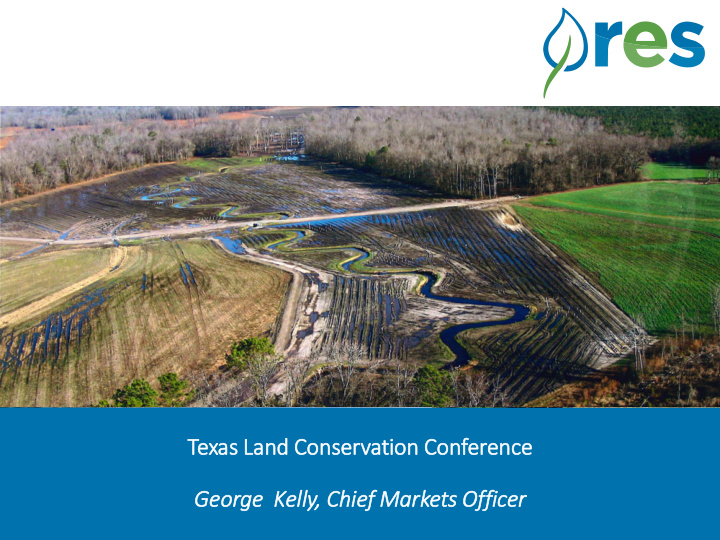



Texas Lan Land Con onservation Con onference Ge George Kell elly, Chi hief ef Mark arkets Offic fficer
Presentation Agenda • Introduction to RES • US: Regulatory offsets (‘mitigation’) : wetlands & streams • Critical elements
RES Company Snapshot Overview Mission RES is the premier provider of ecological and Resource Environmental Solutions (RES) delivers comprehensive ecological restoration and water water resource solutions in the US RES founded in 2007 resource solutions that help project developers obtain required permits and stay in compliance In 2014, RES acquired EBX, founded in 1998 when projects impact wetlands, streams and In 2016, RES acquired Angler Environmental, habitats founded in 1999 40,400 acres of restored and protected wetlands We help clients manage risk from operations in 180+ miles of streams restored and conserved environmentally sensitive areas by providing 225 mitigation sites, completed or in process proactive project impact analyses, streamlining 20,000 acres of custom, turnkey mitigation permitting processes, and limiting liability and regulatory exposure solutions Over 350 stormwater management facilities designed and constructed 600 commercial, municipal and residential stormwater management facilities maintained 240 tons of water quality nutrient reductions 400 erosion and sediment control inspections at active construction sites across eight states 3,700 acres of endangered species habitat restoration and preservation 10,000,000 restorative trees planted across all operating regions Over 1,750 federal and state permits received using RES-supplied compensatory mitigation solutions.
Ecological Restoration & Water Resource Solutions Solution Delivery Wetland and Species Impervious Stream Habitat and Acre/ Offsets Mitigation Reduction Nutrient and Buffer Credits Stormwater Ecological Compliance Monitoring Construction Inspection and Success History Maintenance Zero project site Zero site violations failures or infractions Achieved all success criteria, performance monitoring and reporting requirements 78.9% tree survivability
Evolution of the Wetland / Stream Market • Market driven by Clean Water Act goal of “no overall net loss” of wetland acres and functions announced in 1989. Applies to streams as well. • From 1989 to 1995, mitigation process was ad hoc. Federal Guidance was issued in 1995, which promoted increased mitigation through private sector. • Three forms of implementation: 1) permittee-responsible mitigation; 2) mitigation banks; 3) payment to in-lieu funds. Last two mechanisms are referred to as third-party mitigation, since responsibility and liability for completion is transferred to a party other than permittee. • New regulations effective June 9, 2008, seeks to promote one standard for mitigation. “Preference” for mitigation banking. 12 uniform components.
Critical Wetland/Stream Market Elements • Clear policy goals and strict enforcement - “no net loss” • Evolution to uniform mitigation standards (although regional variation allowed for technical approach) • Rigorous certification process of mitigation process • Mitigation easily understandable by impactors (Compensation ratio 1-2 times impact) • Permanency of land protection • Transfer of liability to mitigation project sponsor if a bank
Resource Environmental Solutions, LLC http://www.res.us Baltimore Baton Rouge Charleston Chicago Fairfax Houston Lafayette Oak Hill Odenton Pittsburgh Raleigh Richmond website wetlands photo here George Kelly gkelly@res.us
Recommend
More recommend